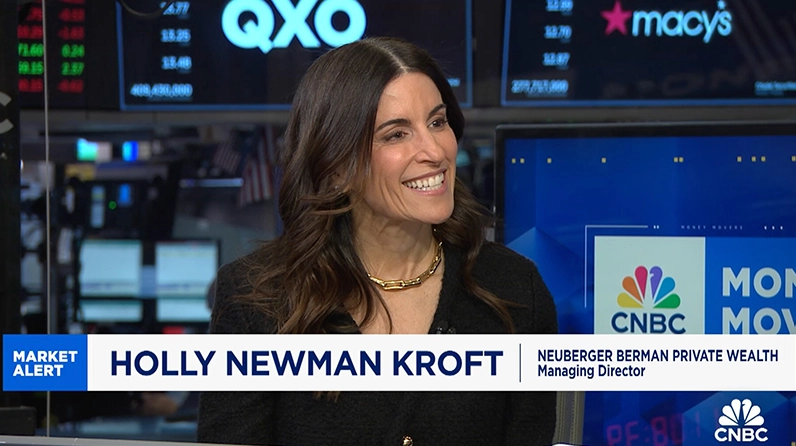

Despite short-term uncertainty, we believe that the U.S. will avoid a meaningful and protracted economic deceleration and that tariffs and trade policy changes may stimulate growth in Europe and Asia, narrowing valuation and earnings gaps
President Donald J. Trump declared a national economic emergency yesterday as the basis for a slate of sweeping global tariffs set to begin over the next week. He cited “large and persistent annual U.S. good trades deficits” which have led to a “hollowing out of our manufacturing base” as rationale in his announcement.
Through the International Emergency Economic Powers Act of 1977 (“IEEPA”), the President announced a baseline 10% tariff rate for all imports from any destination country to go into effect on April 5th. He also announced meaningfully higher tariffs for sixty of the “worst offenders,” including tariffs of 34% on China (on top of the 20% levy already announced), 20% on the European Union, 32% on Taiwan, 25% on South Korea, 46% on Vietnam, and 49% on Cambodia. These reciprocal tariffs are set to go into effect on April 9th.
Notable exclusions to the reciprocal tariffs are steel, aluminum, autos and auto parts, copper, pharmaceuticals, semiconductors, lumber, bullion, and energy and certain minerals that are not available domestically. In addition, the current 25% proposed tariffs on Canada and Mexico remain in place, but nothing more has been announced for those two countries. The implication is that USMCA compliant goods will not be subject to any tariffs while non-USMCA compliant goods and non-USMCA compliance energy will be subject to 25% and 10%, respectively.
Equity, bond, currency, and commodity markets globally are reacting to the news, with U.S. equities down meaningfully to open the trading day. U.S. growth stocks and small cap names are faring the worst in early trading while the S&P 500 is facing its sharpest decline in two years. European and Asian equities also traded lower on the news but were down less than their U.S. counterparts. Yields are also moving lower, as the 10 Year Treasury now sits just above 4% -- well off its 2025 high of 4.8%. The VIX, often used as a measure of volatility for the U.S. market, surged over +20% following the announcement, and while gold was down modestly, it breeched an all-time high in yesterday’s session; the dollar is also off more than -2%.
Concerns center on the impact of higher prices on both consumers and businesses. U.S. consumers have little appetite or ability to withstand another round of price increases so quickly following the recent bout of inflation. Businesses, therefore, may struggle to pass the price increases through their supply chains and/or to end consumers which may weigh on margins and the anticipated acceleration of earnings in 2025. Even if tariffs are negotiated lower or removed – the White House statement noted that the President could roll back the tariffs if he believes the threat is “satisfied, resolved, or mitigated” – the overhang of uncertainty is unlikely to lift fully in the near future; this points to an inflection of economic activity likely delayed to the back half of year if more clarity is delivered.
What remains up for debate as it relates to the President’s actions is if this is part of an aggressive approach to engender concessions from trading partners or if it is indicative of a broader, longer-term plan to generate meaningful revenue to offset the spending necessary to deliver on Trump’s tax promises while also shrinking the budget deficit. Our view remains that the reciprocal tariffs are likely to result in negotiation with some of our trading partners and the more specific actions already announced for Canada and Mexico, with no further escalation today, point to a goal of renegotiating the USMCA well ahead of its 2026 planned review.
Post-press conference comments from U.S. Treasury Secretary Scott Bessent pointed to the announced tariff rates as the “high end,” provided that countries do not retaliate. He also noted that his focus, and that of Congressional Republicans, is now squarely on passing the tax bill, which includes not only the extension of tax cuts within the 2017 Tax Cuts & Jobs Act (“TCJA”), but also potentially a suspension of taxes on tips and Social Security payments as well as the deductibility of interest paid on auto loans for purchases of American made autos.
While tariff revenues will certainly be a welcome addition to the assets side of the balance sheet, we believe that maximizing that revenue source is unlikely to be the primary driver for the Trump Administration. We are also encouraged by the shift of attention to addressing both the looming debt ceiling breach and the expiring tax cuts as this reflects one of the key platform promises that is likely to cushion the sentiment blow inflicted by today’s announcement. Evidence of meaningful progress in cementing the pillars of the TCJA and demonstrating a concerted effort to tackle the burgeoning budget deficit could help create a ceiling on long-term yields which would be beneficial for borrowers across the U.S. economy – not least of which is the U.S. government.
However, we would be remiss not to acknowledge that the level of uncertainty, at least in the short-term, has been raised by these actions. Retaliation is likely, particularly from the “worst offenders.” There are likely to be countries which take issue with the Trump Administration’s calculation of “tariff charged on the U.S.” given that this was based on the trade balance versus the actual levies on U.S. goods – and therefore is difficult to counter in the short to mid-term. Recession risk and inflation expectations are likely to increase modestly and the combination of potentially slower growth and higher prices will once again shift attention to the Fed and the difficult position it may be in should tariffs of this magnitude remain in place for an extended period.
Despite this overhang, we believe that the U.S. will avoid a meaningful and protracted economic deceleration. We expect uncertainty to ease as we move closer to the second half of the year and believe a sustainable rotation away from 2023–2024 equity market leaders is underway as U.S. trade policy changes encourage growth stimulus in Europe and Asia, narrowing gaps in earnings growth and valuation. We maintain a balanced view on asset allocation, focusing on diversification across regions, sectors, and styles to manage risks from both inflation and growth slowdowns.


VIDEO
Holly Newman Kroft Discussed Market Uncertainty on CNBC

VIDEO
Celebrating Women’s History Month 2025

INSIGHTS
CIO Notebook: Fed Holds Rates Steady but Projections Reflect Policy Uncertainty

INSIGHTS
Private Equity in Perspective: Navigating Extremes and Unlocking Long-Term Value

INSIGHTS
CIO Notebook: Cooler Inflation Calms Nerves but Tariffs Still Loom Large

Accolades
Our Advisors Ranked in “Barron’s Top 1,200 Financial Advisors” List for 2025

INSIGHTS
CIO Notebook: Light U.S. Payrolls Close Out a Noisy Week
MARKET COMMENTARY
Trade Debates While Markets Rotate
INSIGHTS
U.S. Tariffs Hit Markets as Growth Questions Emerge
VIDEO
Holly Newman Kroft Joined CNBC to Discuss Market Outlook
Accolades
Forbes | SHOOK 2025 Top Women Wealth Advisors
INSIGHTS
CIO Notebook: Hotter Inflation Creates Doubt for Investors
INSIGHTS
CIO Notebook: January Payrolls Light but U.S. Labor Market Still Strong
IMPORTANT INFORMATION:
This material is provided for informational purposes only and nothing herein constitutes investment, legal, accounting or tax advice, or a recommendation to buy, sell or hold a security. This material is general in nature and is not directed to any category of investors and should not be regarded as individualized, a recommendation, investment advice or a suggestion to engage in or refrain from any investment-related course of action. Any views or opinions expressed may not reflect those of the firm as a whole. Neuberger Berman products and services may not be available in all jurisdictions or to all client types. Diversification does not guarantee profit or protect against loss in declining markets. Investing entails risks, including possible loss of principal. Investments in private equity are speculative and involve a higher degree of risk than more traditional investments. Investments in private equity are intended for sophisticated investors only. Unless otherwise indicated, returns shown reflect reinvestment of dividends and distributions. Indexes are unmanaged and are not available for direct investment. Investing entails risks, including possible loss of principal. Past performance is no guarantee of future results.
Portfolio positioning views expressed herein are those of Neuberger Berman’s Private Wealth Investment Group, which may include those of the Neuberger Berman’s Asset Allocation Committee. Asset allocation and positioning views are based on a hypothetical reference portfolio. The Private Wealth Investment Group analyzes market and economic indicators to develop asset allocation strategies. The Private Wealth Investment Group works in partnership with the Office of the CIO. The Private Wealth Investment Group also consults regularly with portfolio managers and investment officers across the firm. The Asset Allocation Committee is comprised of professionals across multiple disciplines, including equity and fixed income strategists and portfolio managers. The Asset Allocation Committee reviews and sets long-term asset allocation models, establishes preferred near-term tactical asset class allocations and, upon request, reviews asset allocations for large, diversified mandates. Asset Allocation Committee members are polled on asset classes and the positional views are representative of an Asset Allocation Committee consensus. The views of the Asset Allocation Committee and the Private Wealth Investment Group may not reflect the views of the firm as a whole and Neuberger Berman advisers and portfolio managers may take contrary positions to the views of the Asset Allocation Committee or the Private Wealth Investment Group. The Asset Allocation Committee and the Private Wealth Investment Group views do not constitute a prediction or projection of future events or future market behavior. Defensive positioning generally means an underweight bias on allocations to risk assets such as equities and alternatives. Positioning views may change over time without notice and actual client positioning may vary significantly. Discussion of yield characteristics or total returns of different asset classes are for illustrative purposes only. Such asset classes, such as equities and fixed income, may have significantly different overall risk-return characteristics which should be consider before investing.
The information in this material may contain projections, market outlooks or other forward-looking statements regarding future events, including economic, asset class and market outlooks or expectations, and is only current as of the date indicated. There is no assurance that such events, outlook and expectations will be achieved, and actual results may be significantly different than that shown here. The duration and characteristics of past market/economic cycles and market behavior, including any bull/bear markets, is no indication of the duration and characteristics of any current or future be market/economic cycles or behavior. Information on historical observations about asset or sub-asset classes is not intended to represent or predict future events. Historical trends do not imply, forecast or guarantee future results. Information is based on current views and market conditions, which will fluctuate and may be superseded by subsequent market events or for other reasons.
Discussions of any specific sectors and companies are for informational purposes only. This material is not intended as a formal research report and should not be relied upon as a basis for making an investment decision. The firm, its employees and advisory accounts may hold positions of any companies discussed. Nothing herein constitutes a recommendation to buy, sell or hold a security. It should not be assumed that any investments in securities, companies, sectors or markets identified and described were or will be profitable. Investment decisions and the appropriateness of this content should be made based on an investor's individual objectives and circumstances and in consultation with his or her advisors.
Neuberger Berman Investment Advisers LLC is a registered investment adviser.
The “Neuberger Berman” name and logo are registered service marks of Neuberger Berman Group LLC.